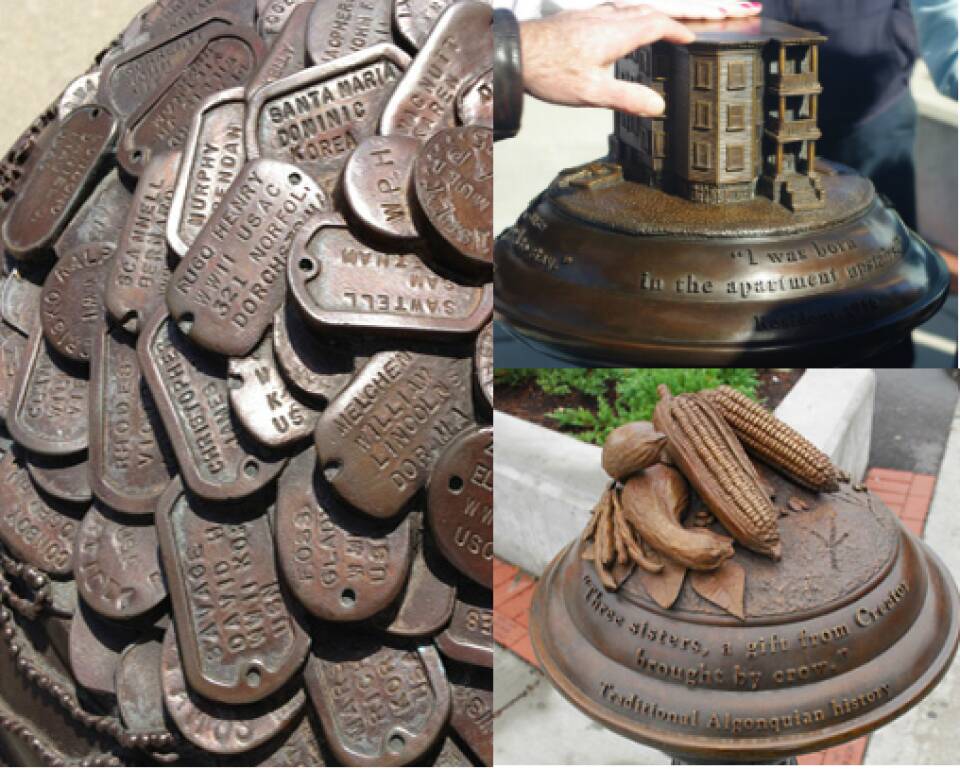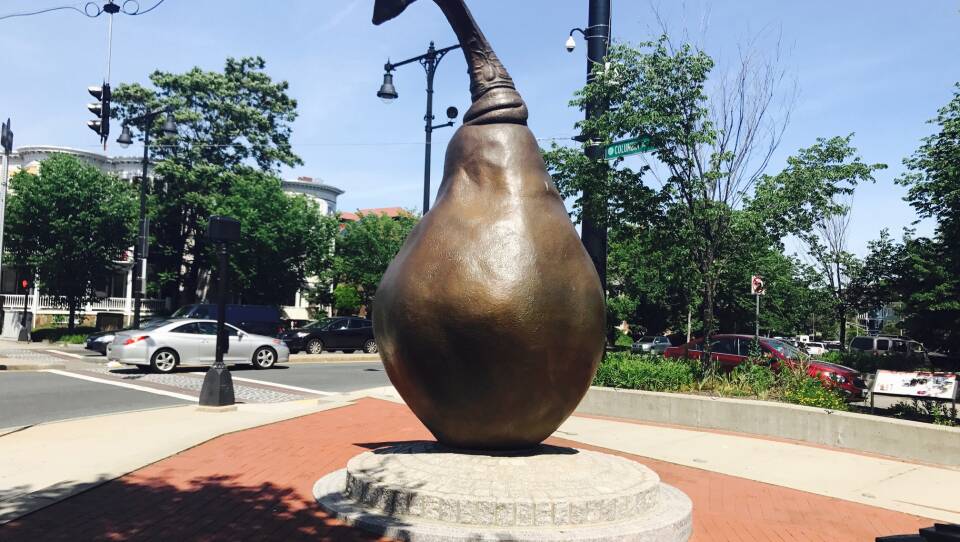If there are two things you can’t spit without hitting in this town, it’s a Dunkin' Donuts and a historic statue.
Paul Revere sits proudly atop his horse in the North End. Puritan provocateur Anne Hutchinson clutches one of her children outside the State House. Heck, even legendary Celtics coach Red Auerbach can be spied chomping a cigar on a bench in Quincy Marketplace.
But back in 2007 when the city wanted to make a historic sculpture, the centerpiece of a renovated Edward Everett Square in Dorchester, artist Laura Baring-Gould decided to go in a different direction. Her idea? A 12-foot tall bronze pear.
"Doing public art is always a tricky endeavor," she told me at her work space in Somerville. "Because who’s the public? What’s the public?"
I headed down to the pear in question on a recent afternoon to chat with a decidedly non-scientifically-selected cross section of that very public.
"I thought it was a peach," said resident Earnest Bradley, who comes through Everett Square at least twice a day. "Now I see it. I never really paid attention to it."
"It’s a landmark," said Rich Flynn, who works in the neighborhood. "I don’t mind it."
As for one Russian-born student living in Dorchester: "It’s the strangest thing ever."
"It’s interesting," said Joachim Luis, an opera singer from Chicago in town for a gig at the nearby Strand Theatre. "What’s the point? I guess Dorchester grew pears or something?"
Yes, indeed! And not only were pears once grown in abundance in Dorchester, one variety was invented here. I learned about this from Earl Taylor, head of the Dorchester Historical Society , which is housed in the Clapp Family’s 18th century farm house. The Clapps were among the founding families of Dorchester, Roger Clapp having sailed from England on the Mary and John in 1630.
"We have Roger Clapp's diary about the voyage and arriving," said Taylor.
And it was on this land in the 1830s that one of Roger's descendants, Harvard graduate Thaddeus Clapp, first successfully cross bred a Bartlett with a Flemish Beauty to create a new variety of pear which he dubbed "the Clapp’s Favorite."
"We have a few trees out here in the yard there, the Clapp's Favorite," said Taylor, pointing through a Historical Society window to a few trees in the front yard. And what exactly does the Historical Society do with these pears?
"Well mostly they get stolen ... and it feeds the community," said Taylor, chuckling.
But to assume this supersized pear is simply a nod to a single moment in pomological history belies why Baring-Gould — and the city — selected it.
In preparing for her proposal to the city, Baring-Gould walked the Dorchester streets for months observing and chatting with people, contemplating how to encapsulate its history in a sculpture.
"I see, in the Vietnamese communities, people growing cucumbers in their gardens," she explained. "And as you cross over into the Cape Verdean communities, people are growing beans."
During visits to the Uphams Corner public library, Baring-Gould learned of the neighborhood’s 17th century farms, it’s 19th century orchards, and saw scores of 20th century photos of kids playing in front-yard fruit trees. She began to realize that there was — and is — a deep agricultural heritage in Dorchester that cuts across culture, class and time.
"And it could also be this unlikely symbol," she said. "What’s a pear doing in Dorchester? Why a pear?"

Baring-Gould says that note of whimsy is a crucial invitation to explore further. Surrounding the pear are 10 smaller bronze works of everyday objects honoring Dorchester’s varied and unique history. They were inspired by those countless conversations she had, like one with Gill Solomon, sachem of the Massachuset-Ponkapoag Tribal Council.
"And he said 'My people have been here for 10,000 years, and there’s not a sculpture for us'," Baring-Gould said.
And so, there — in bronze — are the three sisters: squash, corn and beans — so vital to the Native culture.
"I was talking to vets who served in Vietnam," said Baring-Gould, "and they said 'Dorchester sent more guys off to Vietnam than any other working-class community, where’s my history?'"
And so, there’s a pile of inscribed dog tags. Then there’s an iconic three-decker house, a pair of colonial-era shoes and others — all of them atop pedestals containing quotes from historic titans and current residents alike.
But in the end, it’s the pear that looms largest here, Baring-Gould hopes as a fitting metaphor for Boston’s most diverse neighborhood. She notes that the Clapp’s Favorite is a hybrid pear, something wholly new made possible by cross-pollination. And the variety, still grown today, is renown for its tough, durable skin that, inside, is as soft and sweet as butter.
"And that described everybody I was meeting in Dorchester," said Baring-Gould. "People in Dorchester are tough. They’re resilient. Their skins are thick. And once you get to know them people will protect you, they’ll defend you, they’ll feed you dinner. I was just taken care of so incredibly during that project."
If there is something you have been itching to know more about, email The Curiosity Desk. We might just look into it for you.





